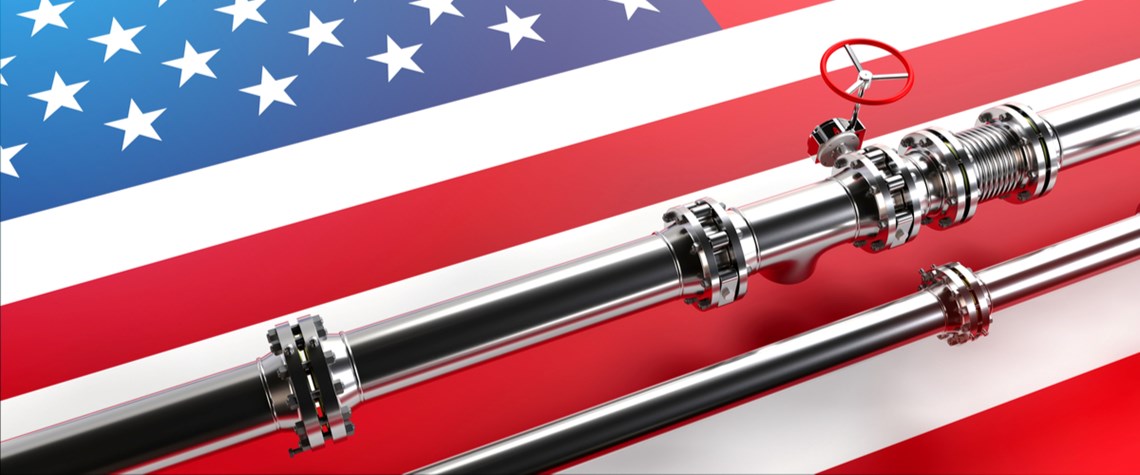Russia’s invasion of Ukraine in early 2022 forced Europe, which had become increasingly dependent on Russia as its primary supplier of natural gas, to face a stark choice: capitulate and accept Moscow’s aggression, or suffer a potentially catastrophic energy shortage with dire economic, political and social consequences. Fortunately, concerted action by the US and its allies produced a ‘Gaslift’ of LNG that flooded European terminals and succeeded in pulling Europe through the first quarter of 2022.
To provide the LNG Europe needed, US producers operated their liquefaction plants at or above 100pc of baseload capacity. From March 2021, when Russia started reducing natural gas supplies to Europe, until June 2022, daily US LNG export capacity consistently operated at or above 100pc of baseload capacity for the industry overall. Running at such high utilisation rates for so long can put a strain on the entire LNG export value chain.
Can the Gaslift be repeated?
Several events already make the chances of reprising the Gaslift more tenuous. The 8 June fire at the Freeport LNG facility removed 15mn t/yr of capacity, 72pc of which had swung to Europe during the 2022 winter. Just ten days after the fire, Russia’s Gazprom reduced gas deliveries to Europe on the Nord Stream 1 pipeline by more than half. Explosions on Nord Stream 1 and 2 on 26 September brought Russian gas pipeline supplies to virtually zero.
European countries have reduced their industrial gas use over the last several months—by some estimates between 10pc and 25pc compared with 2021—to fill their gas storage sites ahead of the coming winter. But that storage will cover only about two months of supply, assuming average winter temperatures.
When Russia invaded Ukraine in February and the US Gaslift to Europe began in earnest, US diplomats asked allies in Asia to consider diverting some of their own cargoes to Europe. Japanese officials agreed their companies would be willing to divert some shipments, so long as Japan retained a “stable” supply.
Only a few days after Freeport’s outage and strikes that immobilised Shell’s Prelude LNG unit offshore Australia, Russia announced the nationalisation of the Sakhalin 2 LNG liquefaction plant. The facility supplies volumes to several countries, including Japan, where it accounts for 10pc of the country’s LNG needs, and South Korea, where c.6pc of LNG imports come from Russia. At the same time, Russia has declared both East Asian countries “unfriendly states” due to their support for sanctions. The Kremlin’s designations of Japan and South Korea as ‘unfriendly’ echo Russian activity in Europe and Ukraine, in which energy supply uncertainty is used to support geopolitical ambitions. China’s live-fire military exercises in August heightened this uncertainty by effectively blockading Taiwan’s two LNG import terminals and closing the Taiwan Strait to LNG traffic.
Rather than having ‘stable’ LNG supplies as winter approaches, Japan, Korea and Taiwan are faced with extremely tight markets riddled with uncertainty. This anxiety was heightened by Australian regulators recommending that the Canberra restrict LNG exports from projects in eastern Australia, although the government recently announced it would not curb exports “at this time”.
Diverting cargoes
Instead of calling on Asian allies to help supply Europe, US producers may have to step in to ensure supplies to allies and trading partners on both continents this winter. As shown in Fig.1, the Gaslift of 2022 was achieved in large part by diverting cargoes from Asia to Europe. With the US LNG industry running above 100pc of baseload and close to 100pc of peak capacity during the Gaslift, there is not much, if any, extra capacity to call upon. If Europe and Asia are both in extremis this winter—whether because of unusually cold weather or due to conflict or other unforeseen events—then US suppliers and their customers will be forced to do their best to allocate available LNG cargoes across both the European and Asian fronts.
Fortunately, additional US supply is scheduled to start production in 2022 and 2023. Cheniere’s Sabine Pass Train 6 and Venture Global’s Calcasieu Pass projects will add 14.5mn t/yr of new capacity in 2022, and hopefully Freeport will also restart its 15mn t/yr of capacity soon. Golden Pass is anticipated to commission its first train in 2023, adding 5.2mn t/yr. An additional 22–25mn t/yr is under construction at Golden Pass and Venture Global’s Plaquemines facilities. Both are planned to start up in 2024. Altogether, US LNG export capacity, based on facilities already under construction, is expected to grow by 20pc before the end of 2022 (not including another 20pc for the restoration of Freeport LNG) and more than 50pc over three years.
Current and pending volumes highlight the influence of US firms in LNG markets in the near and medium terms. No other country has added significant liquefaction capacity in 2022 to date. The only two non-US operations slated to begin production this year are Indonesia’s Tangguh LNG Train 3 (3.8mn t/yr) and Coral-Sul FLNG (3.4mn t/yr) in Mozambique. And in 2023, only one facility—in Congo-Brazzaville—is supposed to begin producing LNG, at 1.4mn t/yr. No new liquefaction addition has been planned outside of the US in 2024. Overall, US LNG export capacity additions for 2022–24 exceed those of all other countries combined.
Even with increased supply, relying on last year’s US playbook is not likely to be enough. What US allies and trading partners seek—and what Russia (and perhaps China) seek to eliminate—are not just promises of energy but, more importantly, the certainty that we will stand by our allies and trading partners even during difficult times. Energy security is a critical part of this certainty, and our adversaries illuminate our vacillations when they occur.
Geopolitical tensions
To this end, it is imperative that government officials avoid giving credence to calls for export bans and trade embargoes. Energy supplies are tight and will likely remain so, in part (but not fully) because of the geopolitical tensions created on both the Atlantic and Pacific fronts. Prices will continue to be high, and there will be calls from some quarters—as there have been already from some in the US, Europe, and Australia—to placate domestic audiences by backing away from the commitments and difficult decisions. Only by showing resolve to meet our trading commitments and providing energy to support our allies will the democratic nations of the world see this and other coming winters through as a united group.
Steven R. Miles is a senior counsel at law firm Baker Botts and a fellow at Baker Institute’s Center for Energy Studies at Rice University. Gabriel Collins and Anna Mikulska are fellows at Baker Institute’s Center for Energy Studies at Rice University.
This article is part of the upcoming special report Outlook 2023, which features expectations from the energy industry for key trends in the year ahead. Sign up here to receive updates about the full report.










Comments